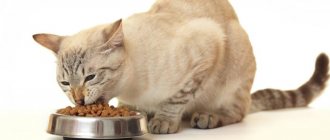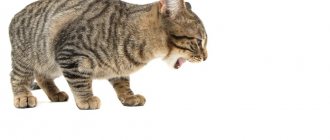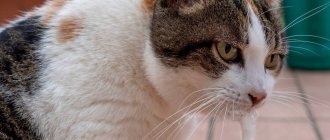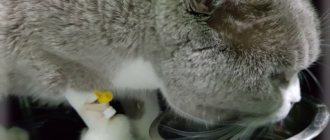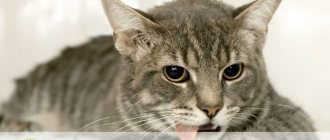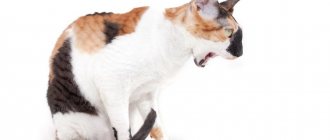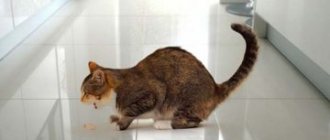25092Administration
6
A pet's illness always brings owners a lot of worries and troubles. A cheerful and mischievous pet suddenly becomes sad and lethargic - this is familiar to many. What if a cat vomits white foam? From a medical point of view, the gag reflex is considered as a natural physiological process that helps the animal empty its stomach.
There may be several reasons that provoke white vomiting. If white foamy vomiting in a cat is repeated many times, this may indicate some kind of disease and cannot be avoided without the help of a veterinarian.
What does vomiting white foam mean?
Vomiting in cats occurs spontaneously. Poor quality food, excess food or liquid, foreign body, chemicals can become a signal for the gag reflex. The animal’s brain also activates vomiting due to more serious reasons - gastrointestinal pathologies, increased intracranial pressure, exposure to external factors, poisoning or the presence of worms.
Veterinarians consider white vomiting a universal symptom and recognize many diseases by it. Cat breeders should know about the causes of vomiting foam and white liquid, and be able to respond promptly and competently to what is happening.
The mechanism of the gastrointestinal tract of cats is similar to that of humans: the bolus of food enters the stomach and is digested there in a few hours. Next, the gastric contents follow into the intestines. In this case, a minimal amount of gastric juice and special mucus remain in the stomach to protect the walls from corrosion. Protective mucus consists of polysaccharides and proteins, which react with oxygen in the air to form a white foam. Therefore, if a cat vomits white foam, then this most likely happened on an empty stomach and without any aggravating factors.
© shutterstock
Medications to prevent vomiting in cats
Anti-vomiting medications are prescribed only after its cause has been established:
- centrally acting antiemetics: Cerucal;
Cerucal is an effective and safe drug that can be prescribed to reduce the intensity or stop the gag reflex
- Torekan.
- Famotidine;
- Heptral;
- Smecta;
- Papaverine;
Natural Causes of White Vomit
The gag reflex and the secretion of white foam in animals are an important defense mechanism against environmental factors, allowing them to get rid of unnecessary and harmful contents of their stomach.
A cat vomiting white foam – causes:
- Wool . Cats belong to the category of clean animals that often lick their skin and keep it neat. Over time, a whole ball of fur accumulates in the animal’s stomach, which provokes foam from the mouth and white vomit. It is recommended that pets with long and thick hair be given special medications (grass, tablets and pastes) to improve the removal of the hairball from the stomach, otherwise health problems cannot be avoided.
- Feed _ It happens that a cat vomits white foam after he has eaten dry food. This happens because dry food swells greatly in the stomach, and it rejects excess food. Dry feeding for cats always requires clean drinking water nearby.
- Hunger . The cat breed is sensitive to lack of food; their digestive system will synthesize all the necessary enzymes and secretions, even if the cat has been hungry for several days. The hydrochloric acid of the gastric juice irritates the mucous membranes of the organs and digestive sections - hence the white foam with vomiting. Your pet shouldn't go hungry!
- Binge eating . Some pets are unable to control the amount of food they eat, so they overeat, then white foam leaves the mouth and a gag reflex occurs due to the excess of undigested food. Swallowing food too quickly without sufficiently chewing chunks and lumps of food can also result in it being rejected from the stomach through the mouth and nose. A distinctive feature of this condition is the presence of pieces of food, white foam and mucus in the vomit.
- Foreign body . Cats are curious and need to taste everything. A pet can swallow any household item, followed by white foam and active vomiting, after which the animal becomes the same – cheerful, affectionate and playful. It’s worse if the pet has eaten or licked medications, chemicals, poisonous or poisonous substances, then unpleasant consequences cannot be avoided.
- Pregnancy . Cats, like women, always feel sick and vomit in the early stages of pregnancy. This is the result of changes in hormonal levels, which is considered normal, and therefore should not cause unnecessary concern to the owners. The gag reflex with white foam can also occur in the last stage of pregnancy, this is due to the voluminous uterus and its pressure on the cat’s digestive organs.
- In heat . Every living creature has an instinct for procreation, and the cat breed is no exception. On average, they come into heat 3-4 times a year, and the animal is distinguished by special behavior. The estrus stage of estrus may be accompanied by nausea, foaming and white vomit.
- Medicines . A pet may react with white foam after taking medications that are prescribed to animals by veterinarians during illnesses and for their prevention. White foam may occur in your pet after taking strong antibiotics. White vomiting can also be caused by Duphalac, which is recommended for animals as a laxative for constipation. A cat may also vomit with white foam from deworming medications.
- Stress . Poor health and nausea can occur against the background of an imbalance in the pet’s psychological state. Fear, changes in living conditions, excitement and other stressful situations in an animal can lead to nausea and vomiting.
© shutterstock
Attention! To avoid the nausea reflex from dry food, alternate it with natural food, periodically change the type of food and always leave fresh water for your pet.
In what cases do we run to the doctor?
This should be done in most situations. If:
- The animal vomits foam or liquid for 3-4 hours;
- vomit is white or yellow, with blood visible in it;
- the potential furry patient vomits for a long time and refuses to eat or drink.
- In addition to the main problem, the cat developed diarrhea, the nose became dry and hot, weakness appeared, the temperature rose and convulsions began.
In such cases, you should not act at your own discretion; you need to contact a veterinary clinic as soon as possible, where the poor fluffy:
- They will make a diagnosis;
- will prescribe antiemetic drugs;
- They will give you a pain reliever that will help eliminate the spasm;
- will prescribe gastroprotectors necessary for the gastric mucosa;
- will prevent dehydration and replenish the lack of fluid with special solutions;
- If necessary, antibiotics and anthelmintic drugs will be prescribed.
The complex of actions described above will help minimize the negative consequences of vomiting and prevent its occurrence in the future.
To prevent more serious diseases, the symptom of which is vomiting, you need to monitor your pet’s diet, get all the necessary vaccinations and carry out regular preventive maintenance against fleas, ticks and helminths. All these measures will help maintain the health of your cat.
Vomiting is considered a sign of a digestive system disorder, but in cats this process may be normal. In some cases, animals specifically eat grass. This triggers a gag reflex, which helps clear the stomach.
If your cat vomits white foam rarely, there is no need to worry. However, if this happens constantly, you should take your pet to the vet, as vomiting can be a symptom of a serious illness.
[custom_ads_shortcode2]
Cat vomits white due to illness
Please note! Symptoms of vomiting in a kitten can indicate a hundred different diseases and abnormalities. It is possible to cure a pet only if the root cause of the gag reflex is accurately established, so you cannot do without a good veterinarian.
White vomiting, as one of the symptoms, is associated with many feline pathologies and diseases:
- Surgical interventions . If the pet has undergone surgery under anesthesia, then often after this the cat experiences attacks of white vomiting and foam from the mouth and nose. After surgery and anesthesia, the animal should remain in conditions of rest and comfort.
- Vaccination . In the modern world, vaccination is the key to a long and healthy life for a cat. Sometimes a consequence of vaccination can be foam and white vomit. Normally, this condition should not last more than 2-3 days in a row.
- Viral infections . Among the most dangerous diseases leading to death are herpes and corona virus infections, rabies, feline immunodeficiency, Aujeszky's disease and panleukopenia. The infectious source is an animal carrier of the virus. Along with white foam and a gag reflex, the pet experiences weakness and refusal to eat, excessive salivation, and an increase in body temperature. One of the most dangerous symptoms is when a cat vomits foam mixed with blood.
- Pathologies of the digestive system . Gastrointestinal diseases in cats always resolve with profuse vomiting and intestinal upset (diarrhea or constipation), severe weight loss occurs with good appetite. In this case, the vomit comes with blood, bile and foam. The animal refuses to eat and drink, and the opposite effect may occur - the pet often eats a lot and actively drinks liquids. The most common of them are ulcers, gastritis and enteritis.
- Helminths . The cat's body is attacked by up to one hundred thousand varieties of worms, which can parasitize the vital organs of the animal. At the same time, the cat exhibits a number of other signs - total hair loss, alternating diarrhea and constipation, changes in appetite and mood, itching in the anus, vomiting with white foam and worms. Against the background of intoxication, immunity decreases, dystrophic changes occur in many internal organs and systems. The animal easily becomes infected and often gets sick, and as a result may even die.
© shutterstock
If a kitten vomits while he is eating, and the gag reflex occurs mixed with belching and white foam, then this indicates muscle weakness of the sphincter located between the esophagus and the stomach. The bolus of food does not pass into the gastric region and is regurgitated by the animal.
The right solution is to feed your pet finely ground food fractionally (5-6 times a day) and in small doses. As the kitten gets stronger, its esophageal muscle will return to normal.
Treatment
Treatment for single vomiting caused by wool, grass, overeating, hunger or vaccination is usually not required. If vomiting recurs and the pet’s condition worsens (refusal to eat, lethargy), a visit to the clinic is mandatory.
If you are vomiting due to food, you need to reconsider your diet. When feeding with industrial food, you need to try options for sensitive digestion, and when eating a homemade diet, contact a nutritionist to create a proper and balanced diet.
Vomiting due to estrus or pregnancy requires treatment if there is any pathology. In case of estrus, which is constantly severe, sterilization may be recommended, and in case of pregnancy pathology, its termination.
Vomiting due to stress in each specific case requires an individual approach. Only a doctor can detect and help eliminate the cause of a cat’s stress, as well as select an individual regimen for administering sedatives.
In case of vomiting caused by helminths , deworming is mandatory. To determine the frequency of treatments and select the right drug, it is recommended to contact a veterinary clinic or contact a veterinarian online. Under no circumstances should you use medications - they can poison the animal.
If vomiting is caused by the presence of a foreign body in the pet's stomach or intestines, surgical intervention is necessary. In this situation, it is strongly recommended not to use petroleum jelly and other folk remedies, as you may waste precious time. If the condition is neglected, pets may develop intestinal necrosis and severe intoxication of the body, often leading to death.
For vomiting caused by other causes (drug poisoning, oncology, kidney disease, etc.) , treatment is developed individually in each case and depends on many factors (age of the pet, presence of concomitant pathologies, severity of the disease, etc.).
Help at home
You can help your pet at home only if the vomiting occurred once and he is in good health and has no other complaints. For example, if an animal vomits something that it recently ate, there is no need to give it anything.
It is also not recommended to self-prescribe antiemetic drugs, as they can not only blur the picture of the disease, but also worsen the pet’s condition (for example, when eating a foreign object).
Diet
For most diseases of the gastrointestinal tract, manifested by vomiting, a diet (food labeled Gastro Intestinal) can help. But it is worth considering that, for example, in case of vomiting caused by kidney disease, a different diet is needed (food labeled Renal). When feeding your pet homemade products, a consultation with a veterinarian nutritionist is necessary to correct the diet.
First aid for a pet
Fact! First aid for a pet with a gag reflex and white foam is a starvation diet for a day, since limiting feeding will reduce the load on the entire body. The consistency, smell and color of vomit will help to recognize the root cause of the illness.
The color and composition of vomit can say a lot about the nature of the animal’s disease:
- vomiting white foam means that the pet is hungry and there is no pathology;
- the presence of white mucus in the vomit indicates a helminthic infestation in the animal;
- vomiting of a pet with saliva without additional impurities with white or yellowish foam can be a sign of terrible diseases - feline distemper or panleukopenia;
- The red tint to the vomit is given by blood, which means that the pet has damage to the organs of the digestive system;
- the gray tint of the vomit suggests the presence of dry food residues in it, and the pet’s diet should be reconsidered for its benefits and health;
- dark color of vomit is a sign of the presence of hydrochloric acid, which can cause gastritis or internal tumor;
- Bile gives the yellow color to the vomit, which indicates dysfunction of the liver and gallbladder;
- the cat vomits water with foam with strong pressure, the reason for this may be a tumor of the internal organs, encephalitis, high intracranial pressure in the animal, thrombosis or brain disease;
- vomit with green foam indicates intestinal obstruction, attacks occur mainly at night;
- A gag reflex involving feces is extremely rare and is a dangerous signal indicating serious intestinal injury.
The pre-cleansing reflex is accompanied by nausea, the pet behaves restlessly and nervously, rushes about, makes plaintive sounds, often licks its lips, and saliva may flow profusely from its mouth.
In addition to nausea, the cat may secrete white foam, breathing becomes faster, the animal pulls its head forward, cramps occur in the stomach, and vomiting begins.
Copious vomit leads to rapid dehydration of the animal's body. At the same time, his saliva becomes viscous white and thick, his eyes become sunken, and his gums stick. Frequent gag reflexes are white with foam at a high temperature plus the depressed state of the pet is a bad signal. What to do then? In this case, the cat urgently needs the help of a specialist .
© shutterstock
It is important to know! One sign of severe dehydration with prolonged vomiting is that if you lift an area of skin and release it, the dehydrated area will slowly return to its original shape.
What to do when a kitten vomits white foam?
- If the gag reflex occurs due to poisoning, the pet is given activated charcoal at the rate of 1 tablet per 10 kg of animal weight. Charcoal is dissolved in water and injected into the cat’s mouth from a syringe without a needle.
- In case of short paroxysmal vomiting, the pet will be helped by drinking Regidron solution.
- Enterosgel and Atoxil will help prevent dehydration due to severe vomiting.
- If the cat is weakened and refuses to take fluids, then it is necessary to inject Ringer's solution.
- An intramuscular injection of Cerucal or No-shpa helps to cope with pain and nausea.
- For frequent and prolonged white vomiting, antiemetic drugs are effective: Torekan, Paspertin and Phenothiazine.
- In case of severe intoxication, the cat is prescribed a course of drips with glucose and ascorbic acid.
- Severe lesions of the gastrointestinal tract are treated with antibiotic blockade and sulfonamide drugs.
Attention! If, despite all the efforts of the owner, the cat’s white gag reflex does not go away within 2 days, the pet must be shown to a veterinarian!
Treatment of vomiting in a cat and the recovery period should be accompanied by a special diet: all food in semi-liquid form, only boiled and soft meat, feeding in small volumes, and sufficient liquid. The appearance of a pet's appetite is a positive sign, but the transition to the usual diet should be carried out smoothly and gradually.
Associated symptoms
The animal's symptomatic picture may be supplemented by discharge from the eyes.
If a castrated or regular cat vomits foam once, then there is no need to worry, since the problem is probably physiological. If the situation repeats itself over the course of a week or month and the pet continues to vomit foamy saliva, then it is recommended to see a veterinarian. In case of pathology, the clinical picture is supplemented by symptoms such as:
- nausea and vomiting of white foam;
- vomit with blood, in which mucous fibers are visible;
- decrease or increase in body temperature;
- discharge from the nose and/or eyes;
- persistent cough;
- weight loss and anorexia;
- depressed state;
- frequent diarrhea or constipation.
When a cat vomits a yellow liquid with foam, it usually does not eat anything and refuses to drink water, which can cause dehydration, which can lead to serious complications.
